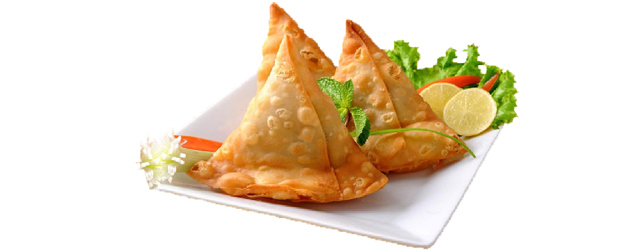The Samosa is the one edible food item that has subtly crept into the cuisine of the rest of the world. You only need to travel to Middle East and to destinations as far as South Africa to stumble upon these delicious curiosities.
With the possibility of a variety of flavours, they are almost certainly as popular as they are because of their appeal to the vegetarian palate. The Samosa is considered by many to be a gift from India to vegetarians worldwide.
Despite its association with Indian cuisine and a must have at any Asian Wedding, historical evidence points to the origins of this savoury pastry to the middle east. It is believed to have been introduced to the Indian subcontinent sometime between the 13th and 14th century by traders that arrived from Central Asia. It has a history of being prepared with meat, ghee, onions and more. Over history and due to different dialects, it name has changed slightly but is still recognisable from its origins. The history books call it a Sanbusah, Sambuusa and in the corners of the earth they call it a Samoosa, but in the modern world, it is known as and still referred to as a Samosa.
The versatility of this delicious small pie like pastry is what enables those that are good in the kitchen to continue to create variety from this little gem.
Here is a straightforward recipe devised from the recipe by Hari Ghotra:
For the filling:
- 1 tsp of rapeseed oil
- 4 boiled potatoes (with the skin on)
- 50g frozen peas
- ½ teaspoon cumin seeds
- 1 tsp of salt
- ½ teaspoon of chilli powder
- 2 chillies, finely chopped
- 1-2 tsp of garam masala
- 1 tbsp. ginger grated
- 2 tbsp. of fresh coriander, chopped
For the paste:
- 1 tbsp. plain flour in a small bowl
- Splash of cold water
For the pastry:
- 200g plain flour
- 1 ½ tbsp. rapeseed oil
- Pinch of salt
- 100ml water
The recipe should be made by making the filling the filling first, then the pastry, filling the pastry and the frying the Samosa.
- Cook the potatoes gently with the skin on and do not allow it to boil vigorously, for 25 minutes until they are soft. Remove from the stove and leave to cool. Once cooled remove the skin with your fingers.
- Cut into small 1cm sized cubes and place in a large bowl
- In a small frying pan heat the oil and fry the cumin seeds. When sizzling, carefully add the peas and fry gently for a few minutes to soften, then remove from the stove and leave to cool before adding the potatoes.
- Add the grated ginger, salt, chilli, chilli powder, garam masala and fresh coriander to the potatoes and stir, check the seasoning and refrigerate for ten minutes.
Making the paste:
- Make some flour glue by adding water to the flour and mix into a thick sticky paste.
Making the pastry:
- Place the flour, salt and oil into a bowl and rub the mixture together.
- Using your hand sprinkle in a little water at a time to bring the dough together.
- Continue adding the water using this method until the joins together. Using wet hands knead the dough until it is soft and no longer sticks to your hands or the bowl.
- Refrigerate for 10 minutes and heat up a frying pan on the lowest setting.
- Make a small tangerine sized ball of dough and roll it between your palms to make a smooth ball.
- Flatten and roll out with a rolling pin to create a thin round disc the size of a side plate, flouring when necessary. Place the disc in a pan for 4 seconds. Remove and place on a chopping board Using a sharp knife cut the disc in half leaving you with 2 semi-circles.
Making the Samosa
- Place one semi-circle on your hand with the flat edge at the top and cooked side facing you. Dip your finger in the paste and spread it across the straight edge.
- Fold in the two corners so they meet in the middle ensuring that one edge overlaps the other and press together to seal all the way down to create an upside down cone.
- Turn the cone over so the pointed edge is at the bottom, using a spoon fill the cone with the potato filling to 2/3 of the way up.
- Deal the opening with the paste, creating a triangle pastry. lie on the tray and pat down to even the filling out. Repeat with the remaining dough until all your samosas have been made.
Cooking the Samosa
- Heat the oil. Test that it’s hot enough by dropping a small piece of pastry in. If it bubbles and floats to the top immediately then the oil is ready.
- Very carefully slip one Samosa into the hot oil being careful that the hot oil doesn’t splash out. Leave the Samosa to cook for a few seconds to cook. As the pastry begins to bubble turn it over using a slotted spoon.
- Leave it to cook gently until it turns golden brown, once its cooked from the oil and set on some kitchen paper. Once you become more confident, fry 2 or 3 Samosas at the same time.
Serve hot and according to taste. They’re great with chutney, but the kids could have them with tomato sauce if the wanted.
Samosa are versatile, try making them with puff pastry or browse our Asian Directory on your mobile to find a local one here https://list.asiandirectoryapp.com/c/Asian-Sweets – that’s awesome!
